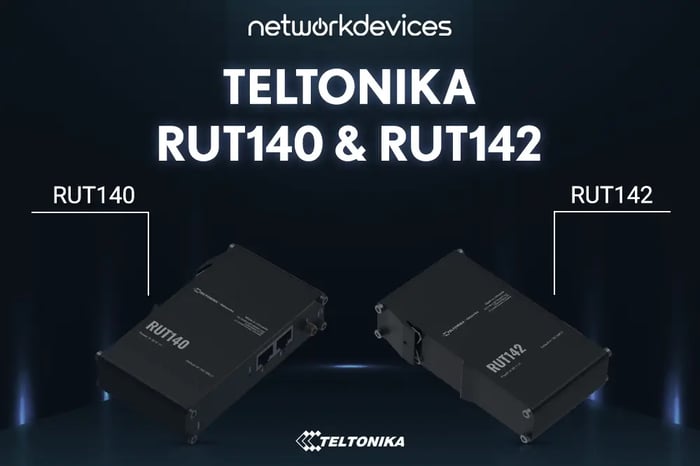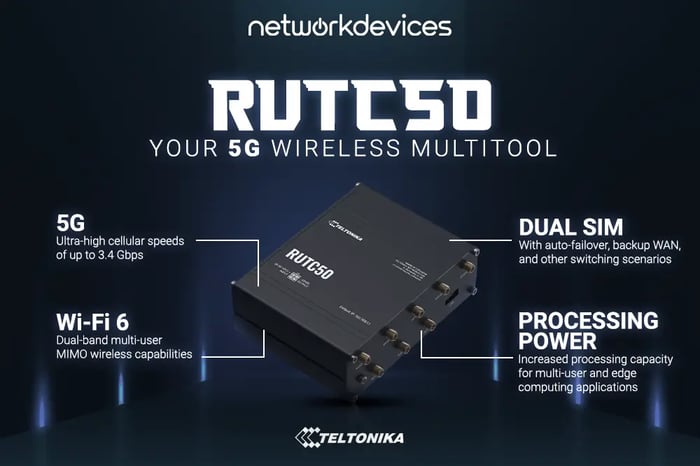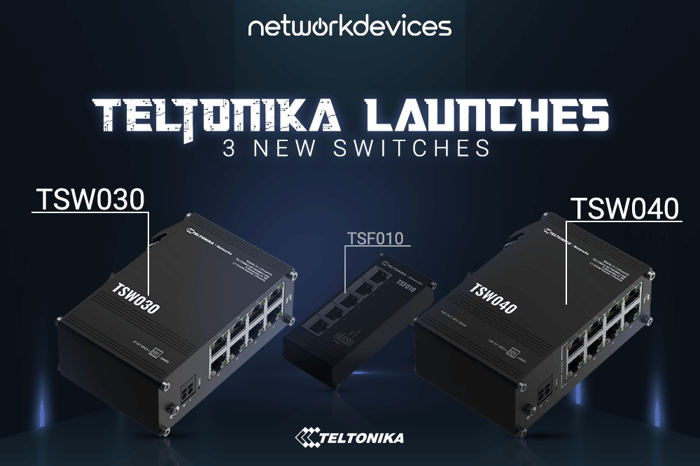You have no items in your shopping cart.

Teltonika RUT140 & 142: Robust Industrial Connectivity
Industrial environments demand high-performance networking solutions. Teltonika Networks offers two standout routers: the RUT140 and RUT142. These routers are designed for industrial networking and offer robust Ethernet and RS232 connectivity.
This article compares the key features of both models, focusing on their roles in network segmentation, remote management, and legacy device integration.
Comparison: Teltonika RUT140 vs. RUT142
| RUT140 | RUT142 |
Connectivity | Ethernet (2x 10/100 Mbps ports) | RS232 Serial Communication + Ethernet |
Wi-Fi | Wi-Fi 4 (802.11b/g/n) | Wi-Fi 4 (802.11b/g/n) |
Network Segmentation | NAT, VLAN | NAT, VLAN |
Modbus RPU Support | No | Yes |
Remote Management | RMS for remote monitoring | RMS for remote monitoring |
Firewall & Security | DDOS Protection, Port Scan Prevention | DDOS Protection, Port Scan Prevention |
Power Input | 3-pin industrial connector | 3-pin industrial connector |
Use Case | Modern Ethernet Networks | Legacy Device Integration (RS232) |
Operating Temperature | -40°C to 75°C | -40°C to 75°C |
Rugged Design for Harsh Industrial Environments
- Both the RUT140 and RUT142 are built for harsh industrial conditions. Their rugged aluminum casing ensures durability, while their compact size (113.1 x 25 x 68.6 mm) allows easy integration into tight spaces.
- The routers are IP30-rated, making them resilient in harsh environments. They operate within a wide temperature range of -40°C to 75°C, ensuring consistent performance even in extreme conditions.
- Additionally, the routers come with a 3-pin industrial connector that includes reverse polarity and surge protection. This ensures reliable power input, making them ideal for factories, energy sectors, and manufacturing plants.
Teltonika RUT140: Industrial Ethernet Router
1. Ethernet Connectivity
The Teltonika RUT140 is designed for modern industrial Ethernet networks. It is equipped with 2x 10/100 Mbps Ethernet ports, providing high-speed connectivity for LAN and WAN. This ensures smooth data flow across industrial environments.
2. Wi-Fi Capabilities
This router supports Wi-Fi 4 (802.11b/g/n), allowing wireless access for remote troubleshooting and monitoring. This feature is particularly useful in reducing downtime, as operators can manage the network without physically accessing the router.
3. Firewall and Security
The RUT140 offers advanced firewall protection, including DDOS prevention and port scan protection. Its NAT and VLAN capabilities enable efficient network segmentation, isolating critical systems from general network traffic and thereby enhancing security.
4. Remote Management
The RUT140 integrates seamlessly with Teltonika’s Remote Management System (RMS). This allows network administrators to monitor and manage the router remotely, minimizing the need for on-site maintenance and troubleshooting.
Teltonika RUT142: Bridge the Gap Between Old & New
RS232 Connectivity
The Teltonika RUT142 extends the RUT140’s capabilities by adding RS232 connectivity, making it ideal for integrating legacy devices that use serial communication. This includes equipment like PLCs, CNC machines, and SCADA systems commonly found in industrial settings.
Modbus RTU Support
The RUT142 supports the Modbus RTU protocol, ensuring smooth communication between legacy devices and modern automation systems. This protocol is widely used in industrial automation to exchange data between sensors, controllers and management systems.
Wi-Fi and Remote Management
Similar to the RUT140, the RUT142 supports Wi-Fi 4, allowing remote access to the router without needing to open control cabinets. Additionally, the RMS (Remote Management System) provides remote configuration and troubleshooting capabilities, reducing on-site interventions.
Firewall and Security
Like the RUT140, the RUT142 includes robust firewall features such as DDOS protection, port scan prevention, and network segmentation with NAT and VLAN. These features ensure that legacy devices can be integrated securely into modern industrial networks.
Real-World Applications: Where Teltonika Routers Excel
Industrial Networking & Automation
Both routers are ideal for industrial networking and automation. With NAT and VLAN capabilities, they enable network segmentation, allowing production lines to run on separate, secure networks. This optimizes data flow and enhances security across operations.
Seamless Legacy Device Integration
The RUT142 is essential for legacy equipment in facilities. Its RS232 port provides seamless integration between legacy devices and modern networks, ensuring continued operation without expensive hardware upgrades.
Remote Management for Reduced Downtime
Both routers are compatible with Teltonika's RMS, which allows for remote management and monitoring. This functionality is particularly useful in industries where reducing downtime is crucial, as it minimizes the need for on-site maintenance.
Conclusion: Long-Term Benefits for Industrial Networking
The Teltonika RUT140 and RUT142 routers provide flexible and reliable solutions for industrial networking. The RUT140 is ideal for Ethernet-based networks, while the RUT142 excels in legacy device integration with its RS232 interface.
Both routers offer advanced security features, network segmentation, and remote management capabilities. These features help industries improve operational efficiency while maintaining long-term cost savings.
Explore the RUT140 and RUT142 product pages for more details.





